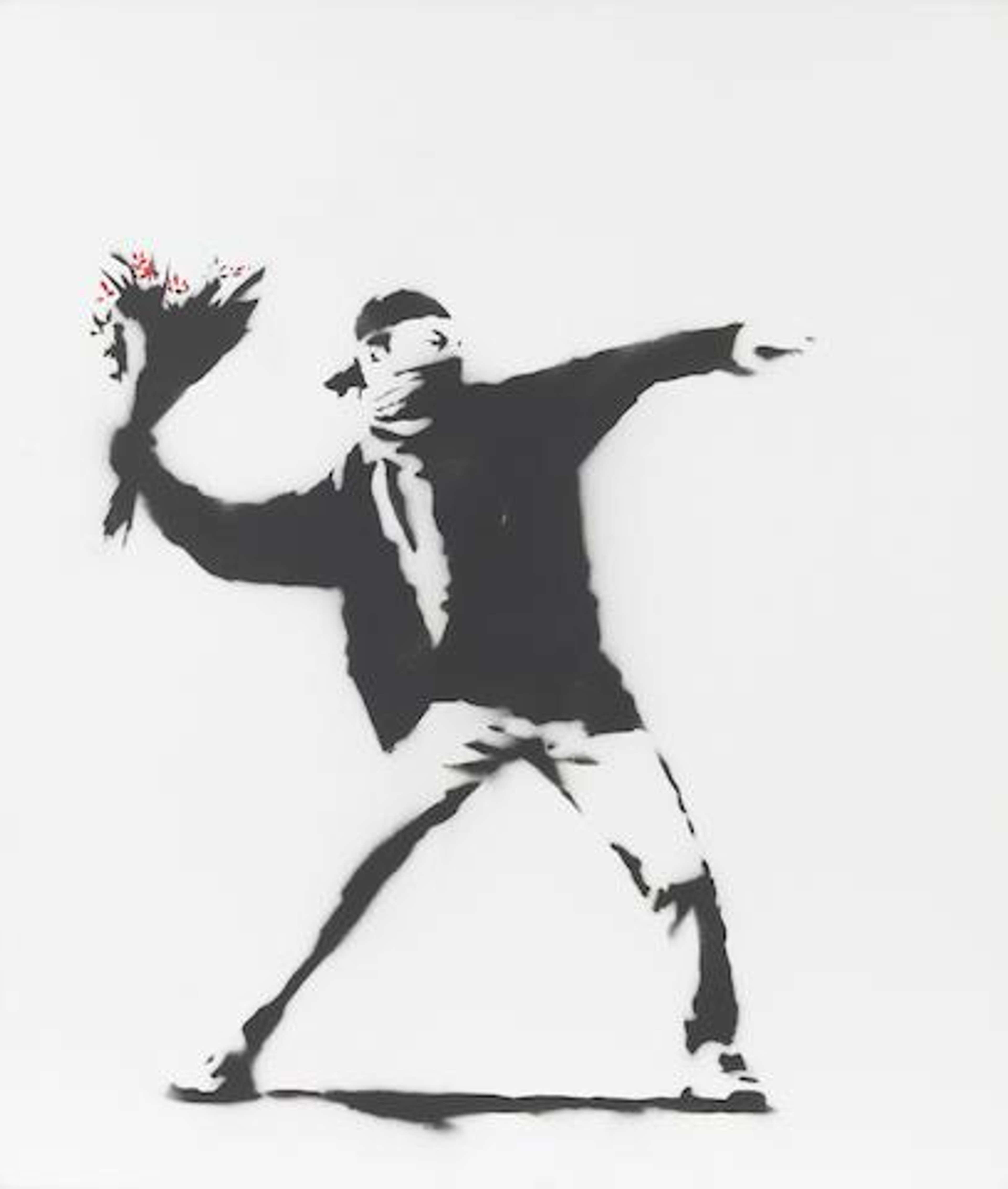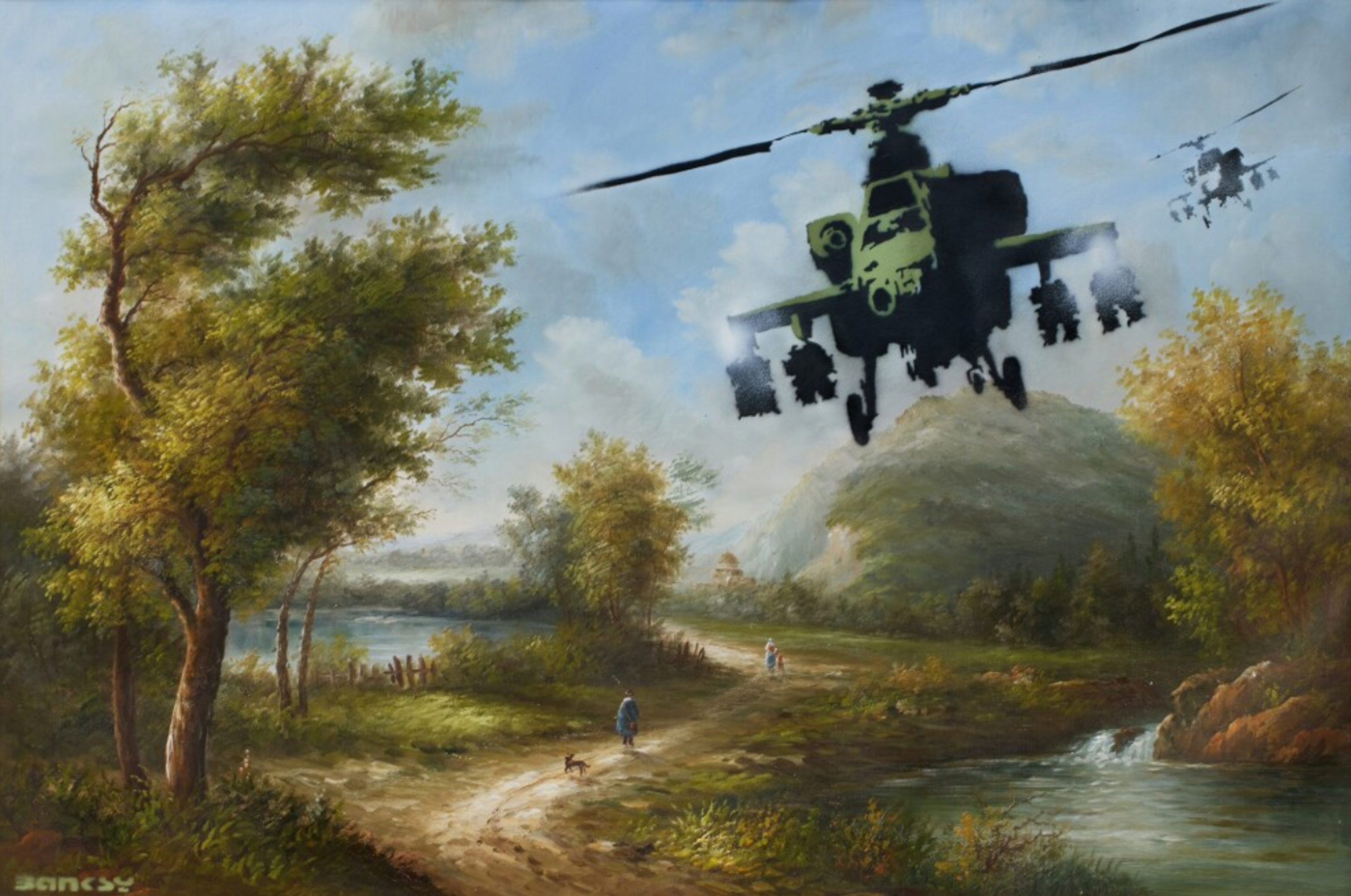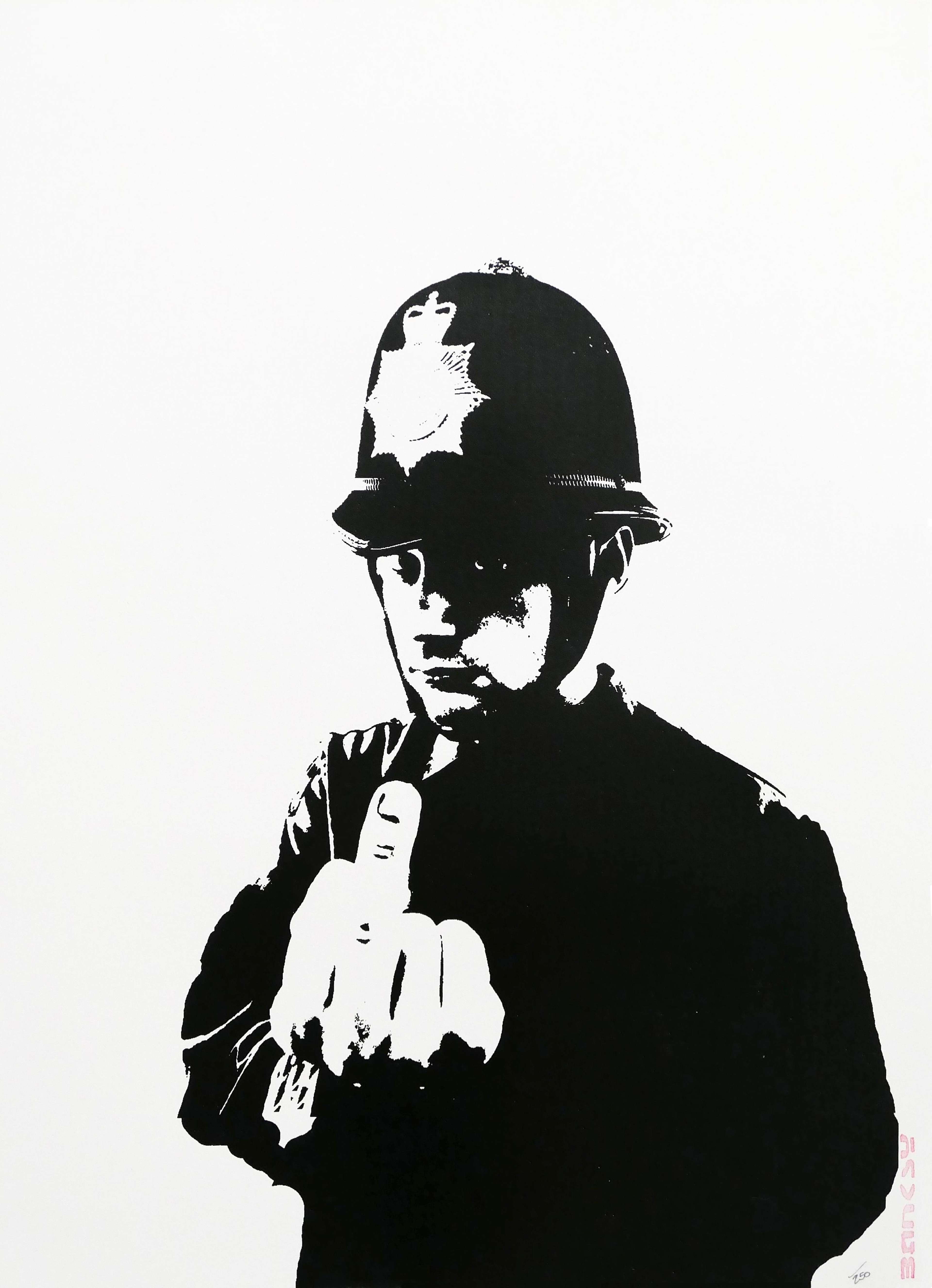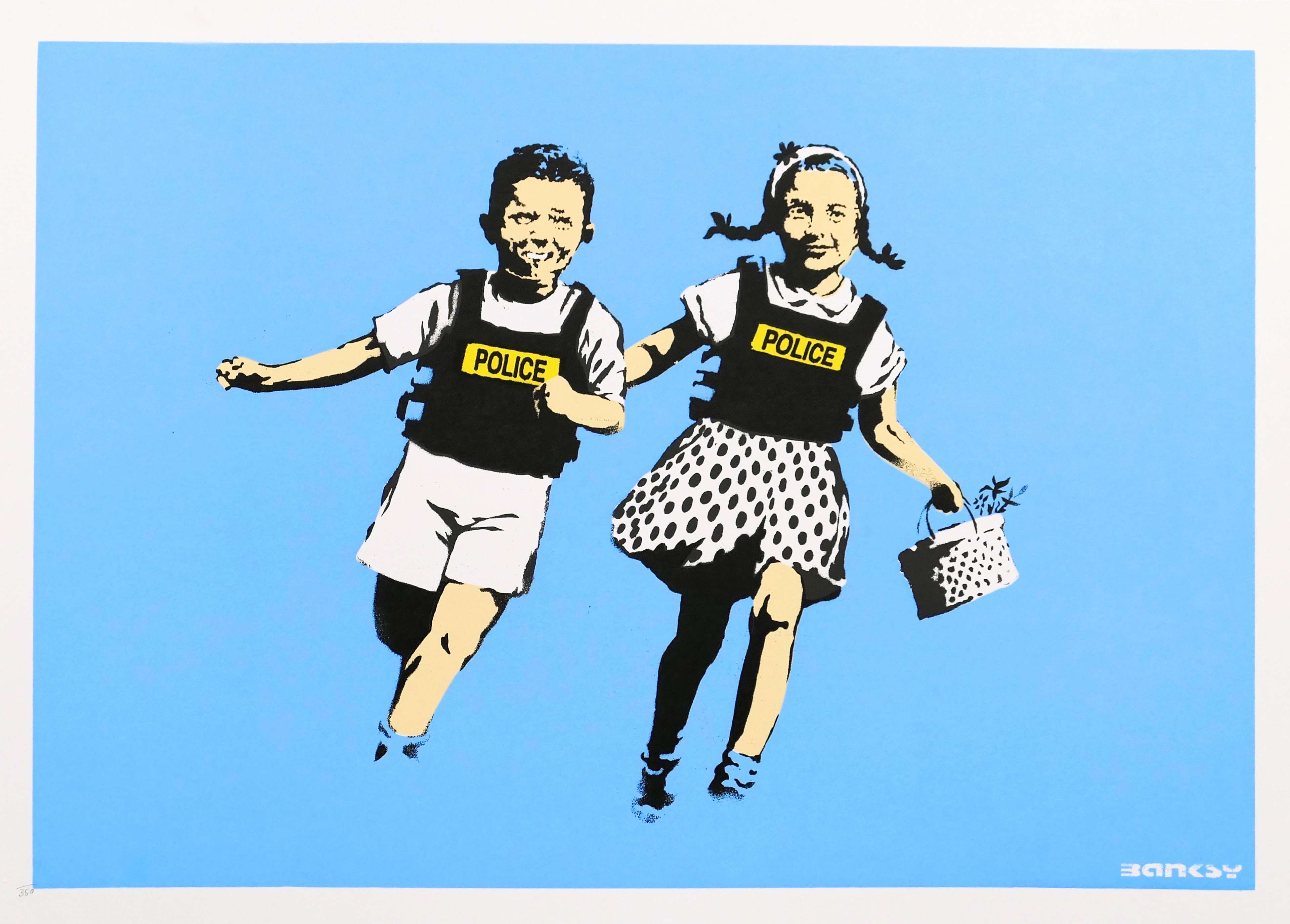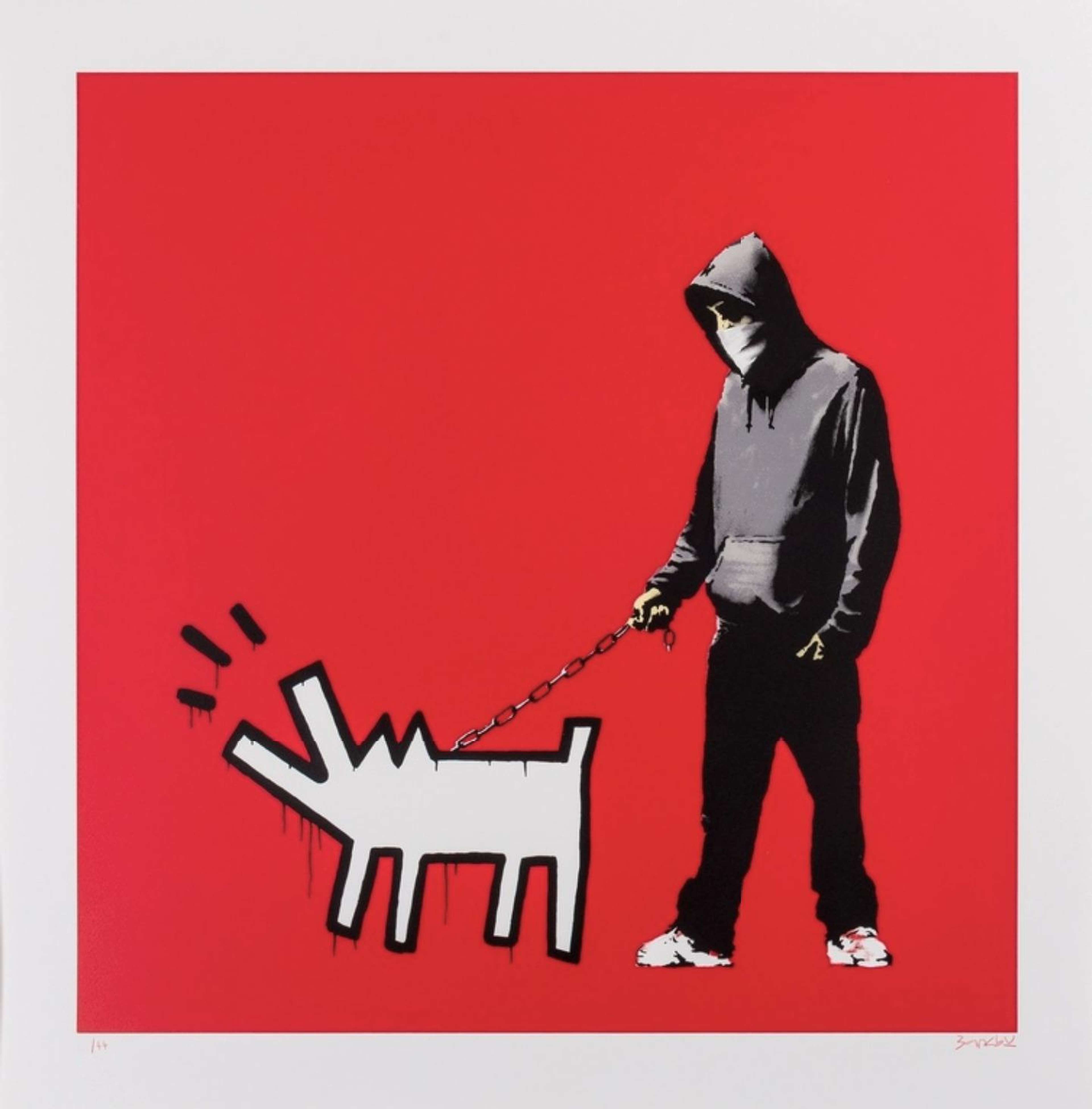 Choose Your Weapon (red) © Banksy, 2010
Choose Your Weapon (red) © Banksy, 2010
Banksy
269 works
Banksy is undeniably one of the most famous and recognisable names in contemporary art. The British graffiti artist has vandalised cities with his art across the globe, from Bristol, to London, to Paris, to New York. With the name Banksy comes publicity frenzies, flocks of adoring fans, and landmark auction house sales.
Likely the most successful graffiti artist in the world, one mystery hangs over this criminal-cum-artist-cum-activist: who is Banksy?
Who is Banksy?
Since his rise to fame as a graffiti artist in the late 1990s, the elusive artist has managed to preserve his hidden identity. A few things have been "confirmed": Banksy is from Bristol, he relies on stencils to work quickly and discreetly, and he is not a fan of authority. We may never know who Banksy is, and the mystery itself is essential to understanding his work.
Who is rumoured to be Banksy?
The longer Banksy's identity has remained anonymous, the more speculation has arisen around his true identity. Some conspiracy theories pertaining to his identity are convincing, some are almost laughable, but none have ever been proven true. Here are some of the top suspects claimed to be Banksy:
Neil Buchanan
Famous in the 90s and 00s for his role in the iconic ITV kid's series Art Attack, Neil Buchanan was embroiled in a Banksy witch-hunt back in 2020. During the national lockdown, a frenzy started on Twitter after Banksy fanatics noticed that Banksy's street art kept cropping up wherever Buchanan was playing with his band, Marseille. While Buchanan would have been the ultimate tongue-in-cheeek brains behind Banksy, he has firmly denied any link to the graffiti artist after being "inundated with enquiries". Banksy even responded to the hilarious conspiracy by spray painting a mural of the Art Attack star, wearing a Banksy sweatshirt, onto Buchanan's own garage wall.
Robert del Naja
One of the more convincing rumours around Banksy's identity was accidentally started by DJ Goldie, aka Clifford Price, during an interview. Goldie let slip that the street artist was actually Robert del Naja, member of the trip hop collective Massive Attack. Del Naja, coincidentally, is also from Banksy's home city of Bristol. Despite Banksy artwork appearing in the locations of Massive Attack's tour however, Del Naja has since publicly denied these rumours.
Robin Gunningham
Regarded as a key contender in the Banksy identity hunt, Robin Gunningham was tracked down by a cohort of criminologists at London's Queen Mary University. By using a technique of geographic profiling that tracks down repeat offenders, Gunningham was located in Bristol. However this geographic profiling technique has one unavoidable flaw: who is to say that Banksy has ever been caught in the act? After years of hiding his real identity and remaining unnoticed in broad daylight, Banksy has proven himself to be a street artist with criminal cunning. Of course, it has never been confirmed that Gunningham is the real name behind Banksy.
Paul Gough
The most recent suspect of being Banksy is British art professor, Paul Gough. The academic actually lectures on street art, and is an acclaimed Banksy expert as well as a painter himself. His scholarly treatment of graffiti art as legitimate 'high art' has led his students to believe that Gough himself could be Banksy. Despite all these rumours, however, the mystery of Banksy's true identity remains intact to this day.
Why do we want to know who Banksy is?
The cult of Banksy is due, in part, to his anonymity. His obscurity is intrinsic to the brand of Banksy, as he is recognisable by name and stencil technique alone. Despite having an instantly recognisable style, we still have a thirst to know who is behind Banksy's work. Perhaps it is out sensationalism of the so-called "genius artist" that spurs our curiosity, or maybe it is because the identity of an artist is so fundamental to the meaning of their work.
Another reason we are so desperate to know who Banksy really is because we seem to have come so close to seeing a glimpse of him at work. Banksy works quickly and quietly, often disguised as a construction worker and masked. Over the years however, Banksy has increasingly teased us. In his "documentary" Exit Through The Gift Shop (2010), Banksy is interviewed in a black hoodie with his face completely obscured. All that remains visible is Banksy's hands, which he waves about mocking those of us who worship the art those very same hands have produced.
Why is Banksy an anonymous artist?
Despite his infamous status in the art world, there is one reason this celebrated street artist remains anonymous. Ultimately, Banksy is a criminal. In Exit Through The Gift Shop, we see Banksy and his street art comrades running from the authorities as they attempt to paint public walls without permission. Whether or not it is a brilliant artist leaving their mark, street art is vandalism. During his early years, Banksy was anonymous for fear of being prosecuted for the criminal damage inflicted by his street art. Nowadays, he continues to paint covertly to dodge the limelight and protect that air of mystery so distinctive to graffiti artists.
Also in Banksy's fictitious film, the artist reveals on camera a project involving a million pounds worth of forged bank notes. With Princess Diana's portrait replacing the Queen's on these "Banksy of England" notes, Banksy himself confessed to the illegality of the artwork. After a few test-runs with the Di-Faced Tenners Banksy opted to retract the notes, although one sold at auction at Sotheby's in 2020 fetched a whopping £30k.
How does Banksy stay anonymous?
When you're as controversial an artist as Banksy, anonymity is appealing if not essential. However, in an age of watchful surveillance and the prying eyes of social media, the secret of Banksy's true identity is becoming increasingly difficult to keep. By keeping his face covered and often making his art in masquerade, Banksy remains in the shadows. As one of the most successful street artists in the world, Banksy also has an extensive team behind him protecting the secret.
Why do so many street artists hide their identity?
When your craft is a crime, keeping your identity hidden is part of the job. Obviously the main motive to remain anonymous is to escape arrest and being prosecuted for making art. More than this however, the anonymous artist is also one who forces the viewer to confront the message of their work, rather than focusing on the artist's biography. So much of Banksy's work has a political satire underpinning its meaning; if we know who the real Banksy is these works may not have such a hard-hitting effect.
For many street artists, it is the simple yet magical effect of the mystery that encourages them to keep their identities hidden. By creating an instantly recognisable iconography, graffiti artists like Stik and Invader make the sightings of their work a treasure hunt of sorts. The ultimate booty however, the identity of the street artist, remains firmly in the hands of the artist.
 The Banksy Story © BBC Radio 4 / BBC Sounds 2023
The Banksy Story © BBC Radio 4 / BBC Sounds 2023Banksy's Identity Revealed as ‘Robbie Banks’?
The great question of Banksy's identity was reignited by a bonus episode of The Banksy Story podcast, which claims to uncover his true identity as ‘Robbie Banks’ through a lost interview from 2003. However, the essence of Banksy's allure extends beyond the simplicity of a revealed pseudonym. Banksy represents a unique paradox in the art world: a figure who both challenges and enthrals the art establishment, reminiscent of other iconoclasts like Andy Warhol and Damien Hirst. His distinctive approach, marked by a blend of anonymity and influential presence.
Banksy's story is more than just a pursuit of his true identity; it's a narrative about the intrigue of mystery and the power of subversion. His ability to maintain anonymity, despite his significant impact on the art world, underscores the evolving dynamics of the art world and market at large.
Banksy Spotted in 2024?
Since his rise to fame in the early 2000s, the general public have had an understandable desire to unveil Banksy's identity. Though Banksy and his team are masters when it comes to creating art stealthily, there have been several supposed sightings of the street artist over the years. In 2024 alone, tabloids like the Daily Mail have published photos of a man who bears a “striking resemblance” to one man rumoured to be Banksy, outside his tree mural in Finsbury Park. The artist himself has never responded to speculation, and the “whodunit” question continues to arise every time Banksy strikes.
How does anonymity affect the art market?
Though anonymity indeed has its perks, it also puts the artist in a precarious position. Back in 2020, Banksy was at risk of losing the rights to his work to a greetings card company because he can't be identified with his own work. Banksy's handling service, Pest Control, offers an authentication checks from the source itself, but Banksy still has relatively little control over the sale of his works.
Without rights to his own work, walls which have been painted by Banksy are often ripped out and sold without the artist's permission, removing them from the public eye. When Banksy knows that his work will appear at auction however, the secret graffitist has always had some tricks up his sleeves. Protected by his anonymity, Banksy has never shied away from calling the art market a bunch of "morons", and ridiculing his million-paying customers by shredding the works they have purchased. The ultimate irony remains that Banksy's anonymity makes his work all the more dramatic, captivating and - ultimately - valuable in the art world he mocks. The secret has become too important to his work, and the real question is: if Banksy came forward and revealed his real identity, would we even believe him?


